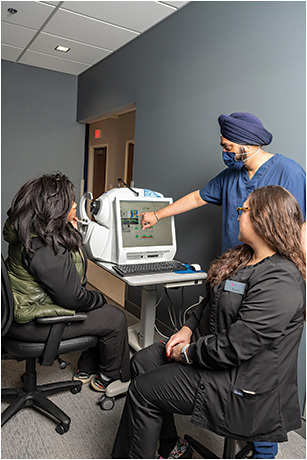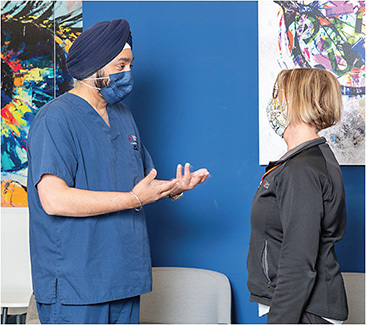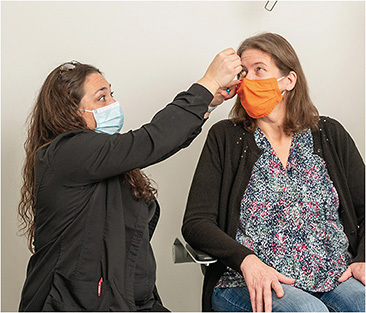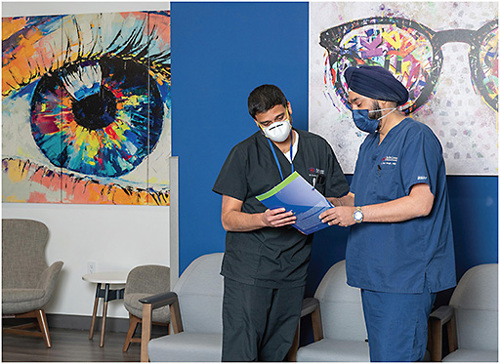PHOTOGRAPHY BY PAMELA KATZ PHOTOGRAPHY
With glaucoma entering a paradigm shift in which quality of life is now a primary goal, The Eye Centers of Racine & Kenosha in Wisconsin has been utilizing minimally invasive glaucoma surgery (MIGS) procedures as a means to get patients to reduce their dependency on drops and ultimately improve their overall satisfaction. Inder Paul Singh, MD, practice president, says that the focus is no longer just on bringing pressures down but also maintaining an environment in which the patient can remain compliant. That has changed his definition of what is considered “controlled glaucoma” — and also the way he practices.

Why drop the drops
Eyedrops that lower intraocular pressure (IOP) and prevent damage to the optic nerve are the most common treatment for glaucoma, according to the National Eye Institute. To maintain their target IOP, patients may be prescribed more than one drop. Still, there are many reasons why it can be beneficial to reduce number of glaucoma drops taken or eliminate them altogether.
Sherri Street, a scribe with the practice, says that affordability is one reason. The practice has found that costs for drops can range anywhere from $200-$600 out-of-pocket monthly for uninsured patients. Manufacturer coupons can reduce the cost to a few hundred dollars, and insurance copays, which vary from plan to plan, can reduce costs to $40-$60 a month. Higher cost, combined with lack of insurance coverage, can lead to decreased uptake or compliance.
“With MIGS, we can treat our patients just as effectively but give them the peace of mind not to worry about the cost every month and how they can stretch it until they can afford a refill,” she says.
The practice also has found that allergic reactions and side effects to IOP-lowering medications can decrease compliance, as can forgetfulness. In addition, patients may have difficulty applying drops properly, which can result in less-than-optimal treatment or wasted drops.
Dr. Singh says that adopting more MIGS procedures and implementing them in the early stages of glaucoma has helped to “simplify” everything — not only for the patient but for the practice, too.
“For the staff, one of the biggest frustrations can be determining whether the patient is truly taking the drop that we prescribed,” he says. “When they come back for a follow-up, they may have switched to a generic or have not remained compliant. These discussions, together with added calls with the patient and the pharmacy, extend chair time and are often required to verify whether the patient is truly in full compliance with the prescribed drop.”

In fact, Dr. Singh says the practice implemented an internal study in which they tracked the time spent with callbacks and verification and found they saved approximately four minutes per patient, per visit once that individual had switched to a MIGS procedure from drops.
“There are so many questions that the techs have to ask if a patient is on drops,” Dr. Singh says. “‘Are you tolerating the medication? Do you ever run out? How often do you forget to take it?’ The techs can really appreciate the way in which MIGS simplifies the process for everyone.”

Dr. Singh has performed MIGS procedures that include iStent (Glaukos), Hydrus (Ivantis), Kahook Dual Blade goniotomy (New World Medical), and viscodilation using the OMNI Surgical System (Sight Sciences) and iTrack canaloplasty microcatheter (Nova Eye Medical).
Witnessing patients’ satisfaction is also motivating for technicians.
“MIGS procedures are my favorite because they are immediately beneficial to the patient,” says Melanie Henry, CST. “Even patients who are apprehensive about having a procedure done are happy about the possibility of reducing their dependency on drops. Explaining to patients that this is a primary goal is an excellent way to lead into the MIGS conversation.”
Focus on education
Patient education is a key factor in the success of MIGS procedures at The Eye Centers of Racine & Kenosha. “How you educate and talk to the patient about these procedures is so important,” Dr. Singh emphasizes.
“The better educated the patient is, the better they do with the overall procedure,” says Franky Cacciato, an ophthalmic technician and surgical educator. “We have found that education leads to compliance.”
Ms. Henry says that the patient script around MIGS procedures usually centers on the prudence of combining these procedures with cataract surgery. Staff point out that the patient is already under anesthesia and an incision has already been made. “We often refer to it as a ‘one-two punch,’ explaining the benefit of having both addressed at the same time,” Ms. Henry says.
Ms. Cacciato explains that education comes from both the technicians and the doctors, and there is a concerted effort to ensure the messaging and language used are the same.
“The techs play a large role in the education process,” she says. “But it’s very important that we are all on the same page. There are multiple touchpoints the patient has with various staff, so we’re focused on making sure techs are also keeping up with education. I have been doing this for 25 years, and I’m still learning.”

Dedicated testing techs
To determine whether MIGS or another intervention is the proper course of treatment for the glaucoma patient, The Eye Centers of Racine & Kenosha employs an abundance of diagnostic tools. These tests include HD-OCT (Cirrus, Zeiss), Ocular Response Analyzer (ORA, Reichert), visual field testing (Humphrey, Zeiss), and pachymetry to measure corneal thickness. To maintain efficiency, the practice has implemented testing technicians whose sole job is to handle the diagnostics. This keeps the flow going for the rest of the staff and the patients.
Ms. Street points out that the arrangement also frees up the doctors to spend more chair time with the patient, allowing the doctors to provide additional education and enhance the patient experience.
“Our work-up technicians can stay on the floor doing initial workup and history with the next patient while our testing technician takes the previous one for the testing they need,” says Ms. Street. “It essentially puts two of us on the floor where there may have only been one without that testing technician. It keeps the focus on the patient and helps to limit the wait time and make sure the patient knows that we believe their time is just as important as the doctor’s time.”
Dr. Singh says that he likes having the visual field (VF) testing performed on the same day as the rest of the patient work-up, but they were previously having difficulty fitting VF testing into the schedule. Now, with testing techs, they are able to keep patient flow streamlined and complete all diagnostics in one visit.
“A testing tech requires more focused training, which therefore allows them to matriculate quickly into the practice,” Dr. Singh adds.
Since these technicians spend all day performing diagnostics, they also become quite proficient at it.
“The beauty of having dedicated testing technicians is that they develop a level of accuracy and consistency that we can really count on,” says Ms. Henry. “They’re also not rushing — that’s their patient and all they have to worry about in that moment. Patients feel well-cared for as a result.”
Convenience boosts conversion
The practice has an in-office surgical suite but also operates out of an ambulatory surgery center and at a hospital. This provides the team and the patient with options. Standalone MIGS procedures are typically performed in the office, which adds a level of comfort to the patient. This option of in-office procedures has also helped increase patient acceptance of standalone MIGS procedures, Dr. Singh says.
Always improving
At the end of the day, The Eye Centers of Racine & Kenosha continues to deliver an excellent patient experience — and improve quality of life — because they are always looking at ways they can evolve and improve. Dr. Singh’s shift in defining “controlled glaucoma” to incorporate quality of life has been a driving factor in these changes.
The growing focus on MIGS procedures, along with the support of an integrated in-office surgical suite and dedicated testing technicians — as well as a commitment to education — has led to the practice’s continued success. OP








